Documents: Go to download!
User Manual
- User Manual - (English)
- Product Information - (English)
- Installation Instruction - (English)
- Getting to know your appliance
- Rinse aid
- Utensils
- Detergent
- Overview of programmes
- Additional functions
- Operating the appliance
- Cleaning and maintenance
- Fault, what to do?
Table of contents
Owner Manual Dishwasher
Getting to know your appliance
Diagrams of the control panel and the interior of the appliance can be found at the front of the manual. Individual positions are referred to in the text.
Control panel

- On/off switch
- Programme buttons **
- Info button

- Display window at top
- Rinse aid refill indicator
- Selection buttons
- Time preselection
- Additional functions **
- START button
- < > button
- Door opener
- Front display *
* depending on the features of your dishwasher
** number depending on the features of your dishwasher
Appliance interior
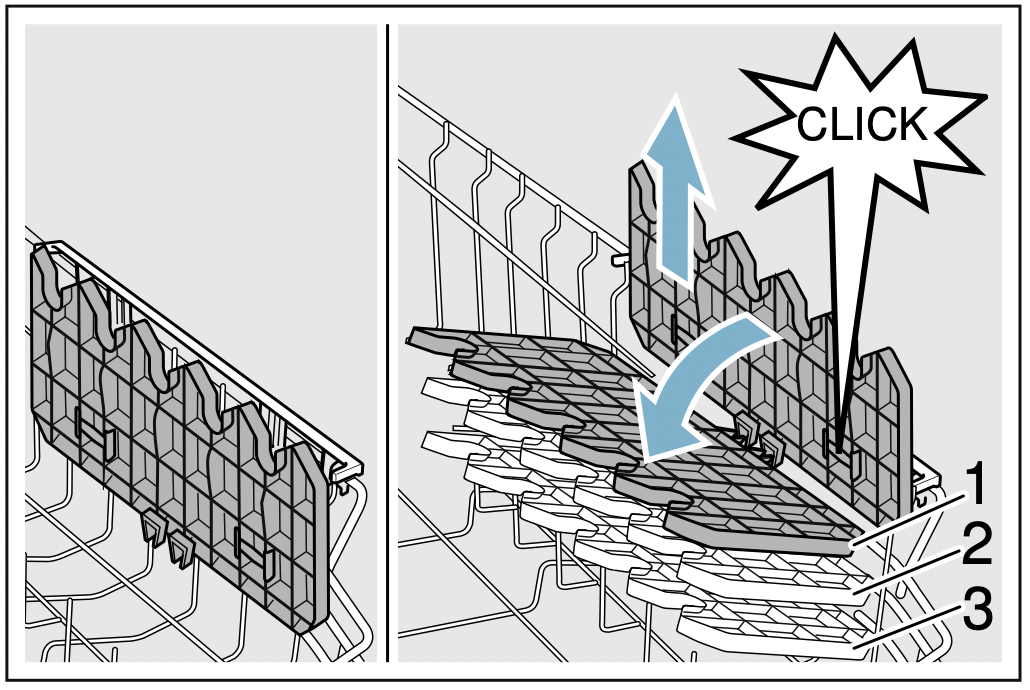
20. Interior light *
21. Cutlery drawer *
22. Top basket
23. Upper spray arm
24. Tablet collecting tray
25. Lower spray arm
26. Filters
27. Cutlery basket *
28. Bottom basket
29. Dispenser for rinse aid
30. Detergent dispenser
31. Lock for detergent dispenser
32. Rating plate
* depending on the features of your dishwasher
Info button 
The Info button  can be used to display additional programme information.
can be used to display additional programme information.
- Press the Info button
 3.
3. - Press the programme button.
Information on the selected programme is indicated on the display window at the top 4. - To leave, press Info button
 3.
3.
Time setting
When the appliance is switched on the for the first time, the time starts at 12:00 o’clock.
Set the time as follows:
- Open the door.
- Switch on ON/OFF switch 1.
- Press Info button
 3 for 3 seconds until the following text is indicated on the display window at the top 4:
3 for 3 seconds until the following text is indicated on the display window at the top 4:
Scroll with < >
Set with - +
Leave with Setup 3 sec. - Keep pressing button > 10 until the time setting is indicated on the display window at the top 4.
- Make the setting with setting buttons + - 6. If the selection buttons + 6 are held down, the set values are changed in 10- minute steps.
- Press and hold the Info button
 3 for 3 seconds.
3 for 3 seconds.
The chosen setting has now been stored.
Note: If the appliance was disconnected from the power supply for a prolonged period, the time starts at 12:00 o’clock. Set the time.
Switching on the appliance for the first time
When the dishwasher is switched on for the first time, you are taken directly to the settings for switching on the appliance for the first time. The following text is indicated on the display window at the top 4:
Scroll with < >
Set with - +
Leave with Setup 3 sec.
The required settings for switching on the appliance for the first time are listed in the table below.
Change the setting as follows:
- Keep pressing button > 10 until the required setting is displayed.
- Make the setting with setting buttons + - 6.
- Press and hold the Info button
 3 for 3 seconds.
3 for 3 seconds.
The chosen setting has now been stored.

Settings
The dishwasher has been preset with certain settings for your convenience. You can change this factory setting.
Change the setting as follows:
- Open the door.
- Switch on ON/OFF switch 1.
- Press Info button
 3 for 3 seconds until the following text is indicated on the display window at the top 4:
3 for 3 seconds until the following text is indicated on the display window at the top 4:
Scroll with < >
Set with - +
Leave with Setup 3 sec. - Keep pressing button > 10 until the required setting is displayed.
- Make the setting with setting buttons + - 6.
- Press and hold the Info button
 3 for 3 seconds.
3 for 3 seconds.
The chosen setting has now been stored.
You have the option of resetting all changed settings back to the original factory settings.
Note: When you reset your dishwasher to the factory settings, you are taken directly to the settings for switching on the appliance for the first time.
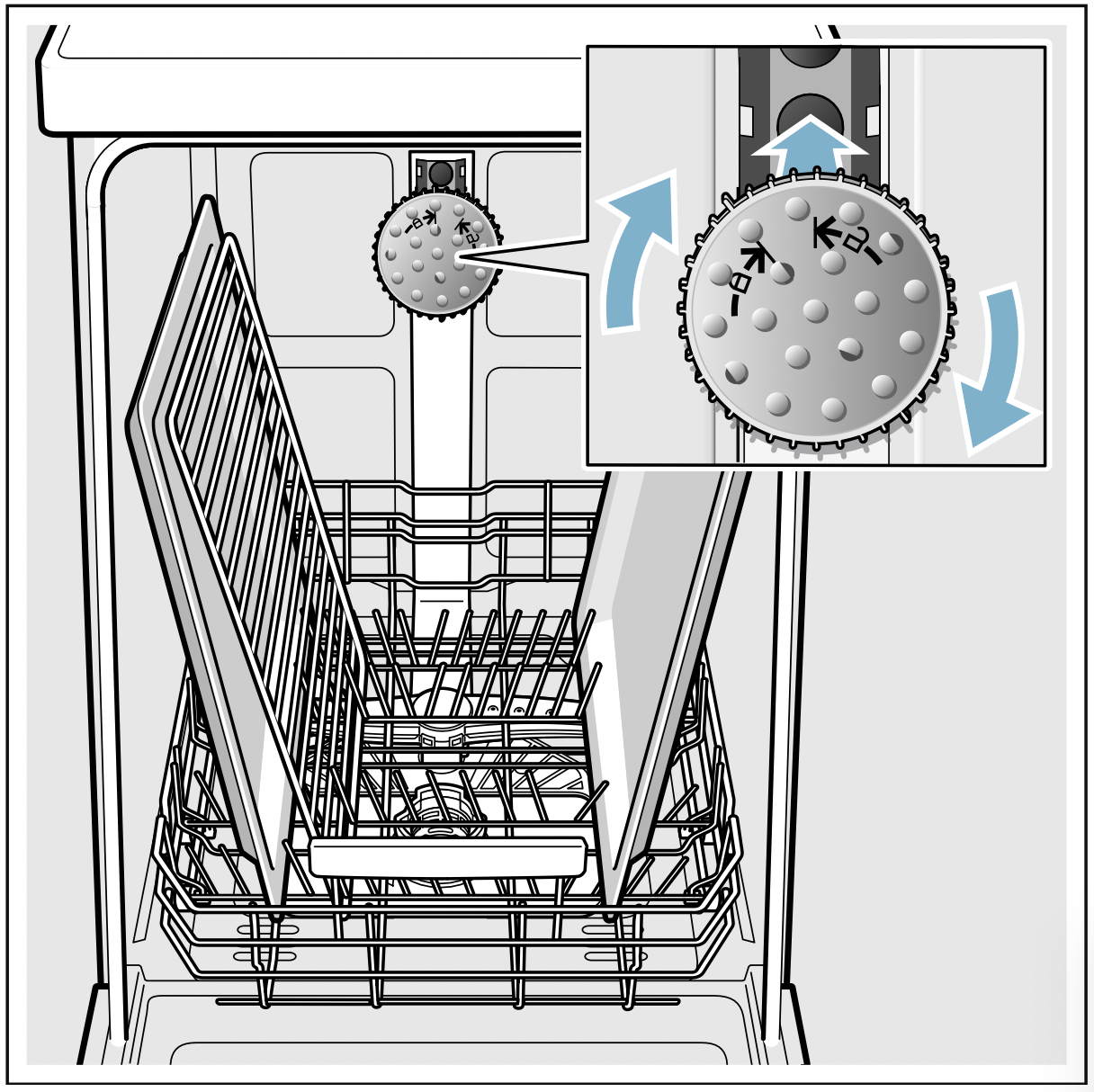
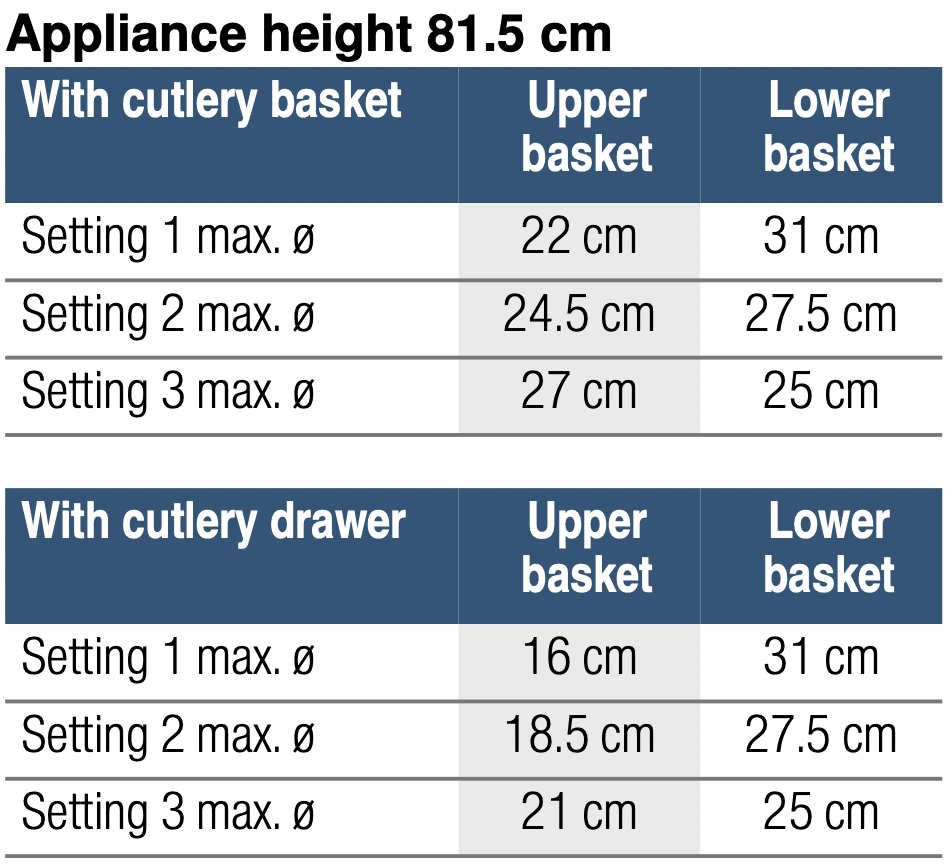
Rinse aid
As soon as the low rinse-aid indicator 5 is lit on the control panel or is requested on the front display * 12, rinse-aid should be topped up.
The rinse aid is required for stain-free utensils and clear glasses. Use only rinse aid for domestic dishwashers. Combined detergents with rinse-aid component may be used up to a water hardness of 21° dH (37° fH, 26° Clarke, 3.7 mmol/l) only. If the water hardness is over 21° dH, rinse-aid must be used.
* depending on the features of your dishwasher
Top up the rinse-aid as follows:
- Open dispenser 29; press lug on the lid (1) and lift (2).
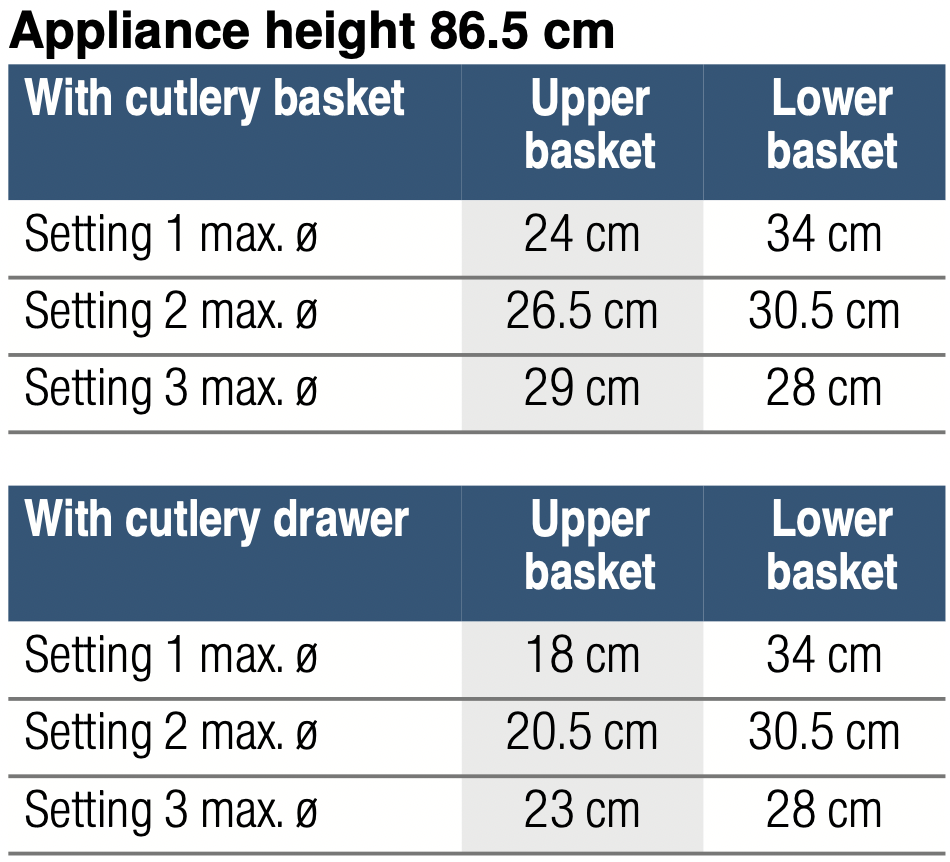
- Add rinse-aid up to the max. mark.
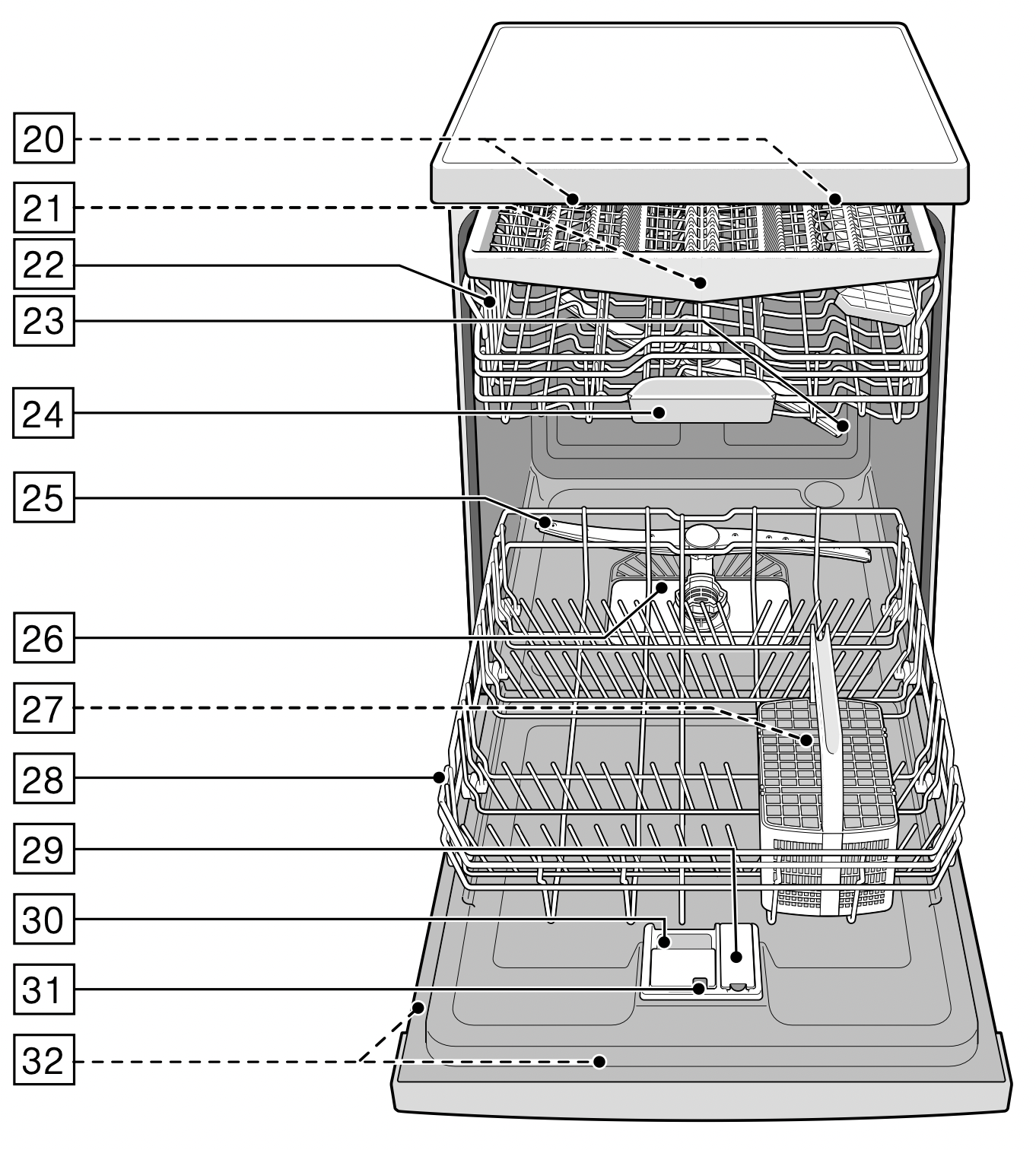
- Close the lid.
Lid “clicks” into position. - Remove overflowed rinse aid with a cloth. This prevents excessive frothing during the next rinse cycle.
Setting amount of rinse aid
The amount of rinse aid to be dispensed can be set from 0 to 6. Set the amount of rinse aid to be dispensed to 5 to obtain a very good drying result. Do not change the amount of rinse aid unless there are streaks or water stains on the utensils. Set a lower level to avoid streaks. Set a higher level to avoid water stains.
Set the amount of rinse aid as follows:
- Open the door.
- Switch on ON/OFF switch 1.
- Press Info button
 3 for 3 seconds until the following text is indicated on the display window at the top 4:
3 for 3 seconds until the following text is indicated on the display window at the top 4:
Scroll with < >
Set with - +
Leave with Setup 3 sec. - Keep pressing button > 10 until the rinse aid dispenser is indicated on the display window at the top 4.
- Make the setting with setting buttons + - 6.
- Press and hold the Info button
 3 for 3 seconds.
3 for 3 seconds.
The chosen setting has now been stored.
Switching off rinse aid refill indicator
If the use of combined detergents with a rinse-aid component impairs the low rinse-aid indicator 5 on the control panel or the text on the front display * 12 (enough rinse aid for x rinse cycles), the displays can be switched off.
Proceed as described under “Setting amount of rinse aid” and select setting 0.
* depending on the features of your dishwasher
Utensils
Not suitable
- Cutlery and utensils made of wood.
- Delicate decorative glasses, craft and antique utensils. These decors are not dishwasher-proof.
- Plastic parts not resistant to heat.
- Copper and tin utensils.
- Utensils which are soiled with ash, wax, lubricating grease or ink. Aluminium and silver parts have a tendency to discolour and fade during the wash cycle. Even some types of glass (e.g. crystal glass objects) may turn cloudy after many wash cycles.
Glass and utensil damage
Causes:
- Glass type and glass production process.
- Chemical composition of the detergent.
- Water temperature of the wash programme.
Recommendation:
- Use only glasses and porcelain which the manufacturer designates as dishwasher-proof.
- Use a detergent which protects utensils.
- Take glass and cutlery out of the dishwasher as soon as possible after the programme ends.
Loading the dishwasher
- Remove large food remnants. It is not necessary to prerinse utensils under running water.
- Place the utensils so that
- they are secure and cannot tip over.
- all utensils with their openings face down.
- parts with curves or indentations are at an angle, thereby allowing water to drain.
- does not obstruct rotation of the two spray arms 23 and 25.
Very small utensils should not be washed in the machine, as they may fall out of the baskets.
Upper basket
Arrange cups and glasses in the upper basket 22.
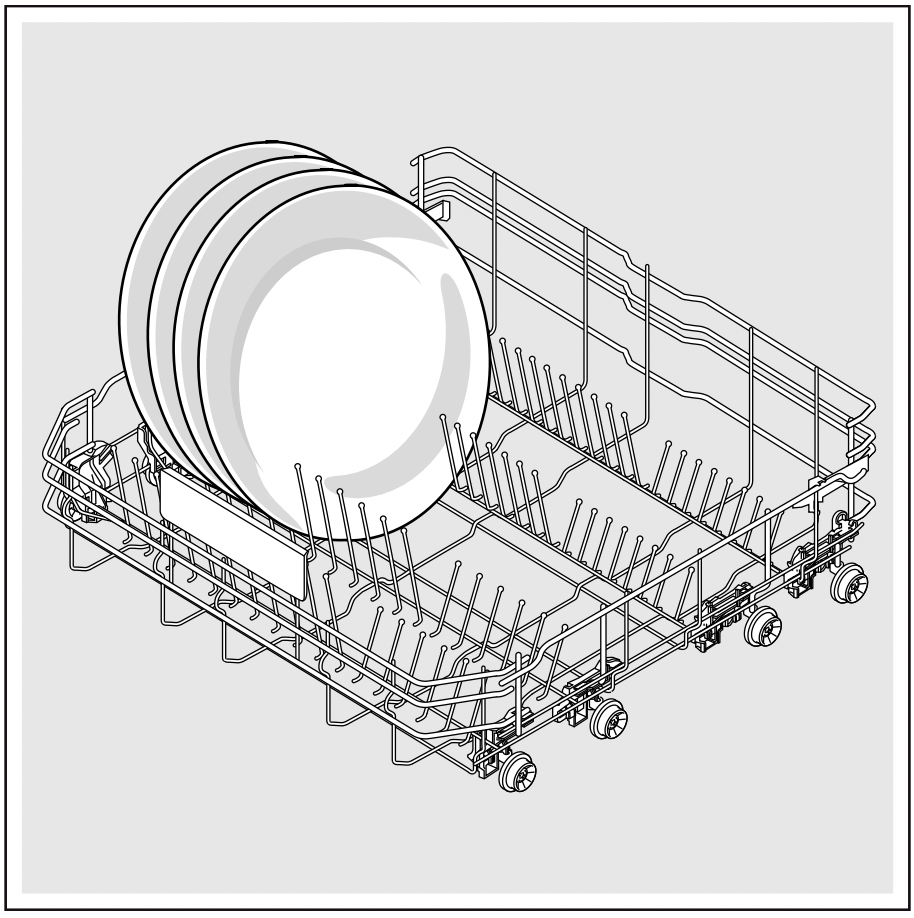
* depending on the features of your dishwasher
Note: Utensils must not be placed above the tablet collecting tray 24. These may block the lid of the detergent dispenser and prevent it from opening fully.
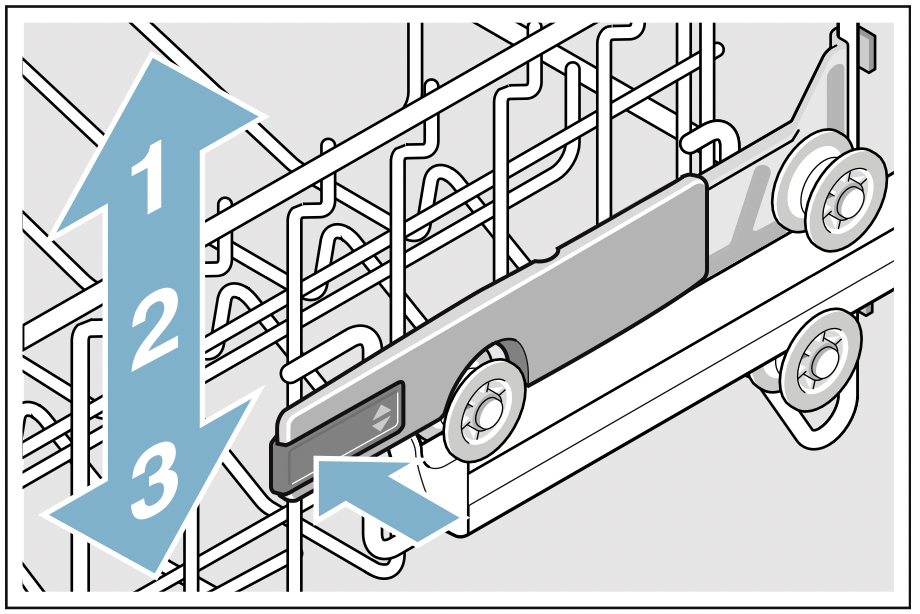
Lower basket
Arrange pots and plates in the lower basket 28.
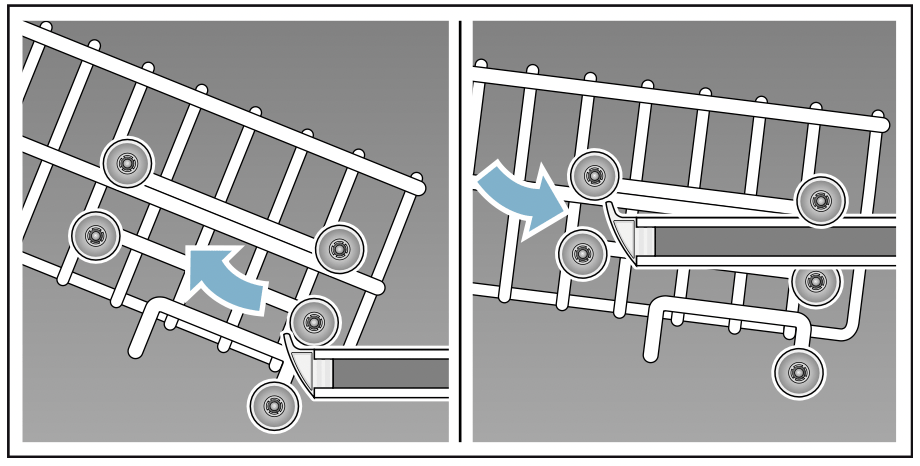
* depending on the features of your dishwasher
Tip: Heavily soiled utensils (pans) should be placed in the lower basket. The more powerful spray jet provides a better dishwashing result.
Tip: Other examples, such as the best way of loading your dishwasher, can be found on our homepage. These can be downloaded free of charge. The corresponding Internet address can be found on the back page of these instructions for use.
Cutlery basket *
Place cutlery, always unsorted with the tips face down, in the cutlery basket *.
To prevent injuries, place long, pointed implements and knives on the knife shelf *.
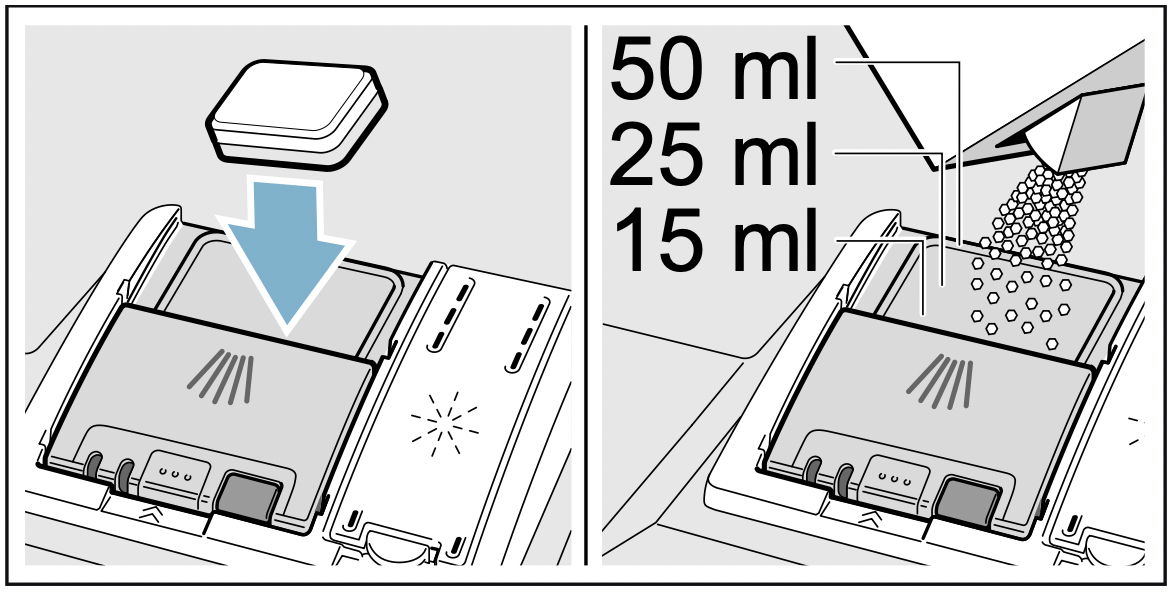
* depending on the features of your dishwasher
Cutlery drawer *
Arrange the cutlery in the cutlery drawer 21 as illustrated. Separately arranged utensils are easier to remove after washing.
You can take out the cutlery drawer.
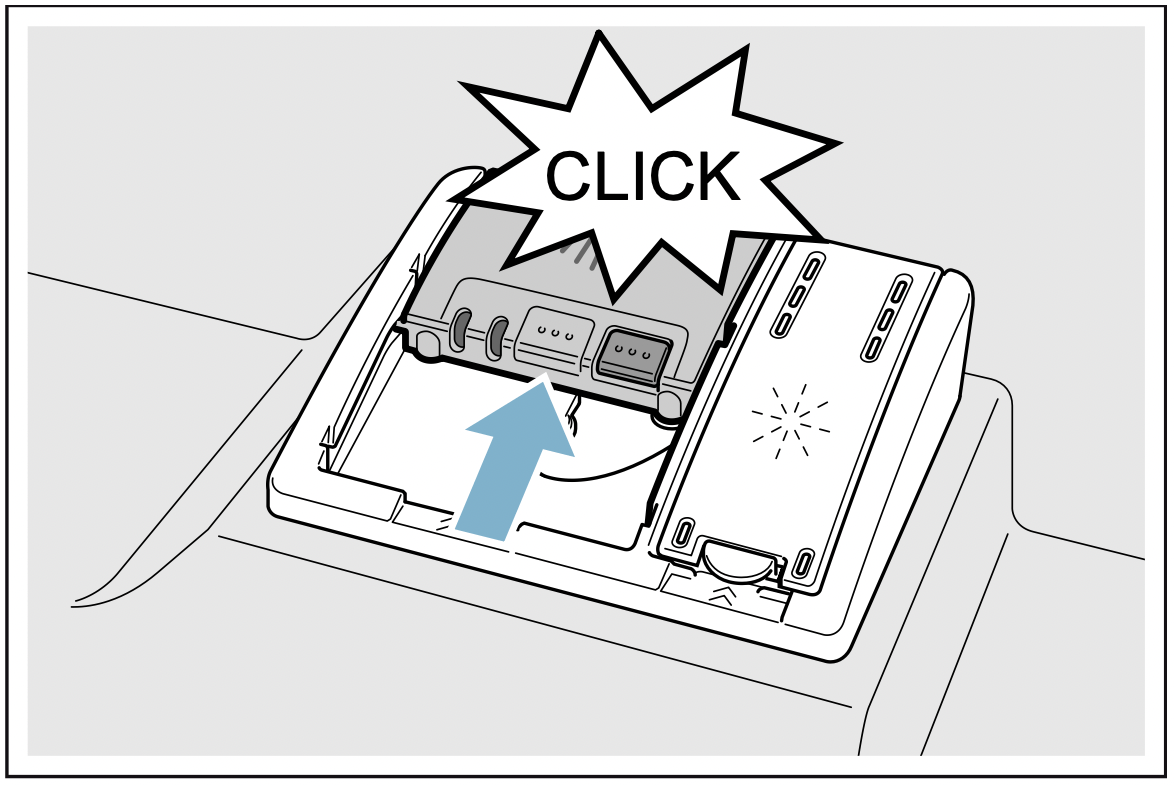
Depending on the features of your dishwasher, you can fold down the side shelves to provide more room for taller items of cutlery. The front rows of prongs can be folded down to provide room for wider handles.
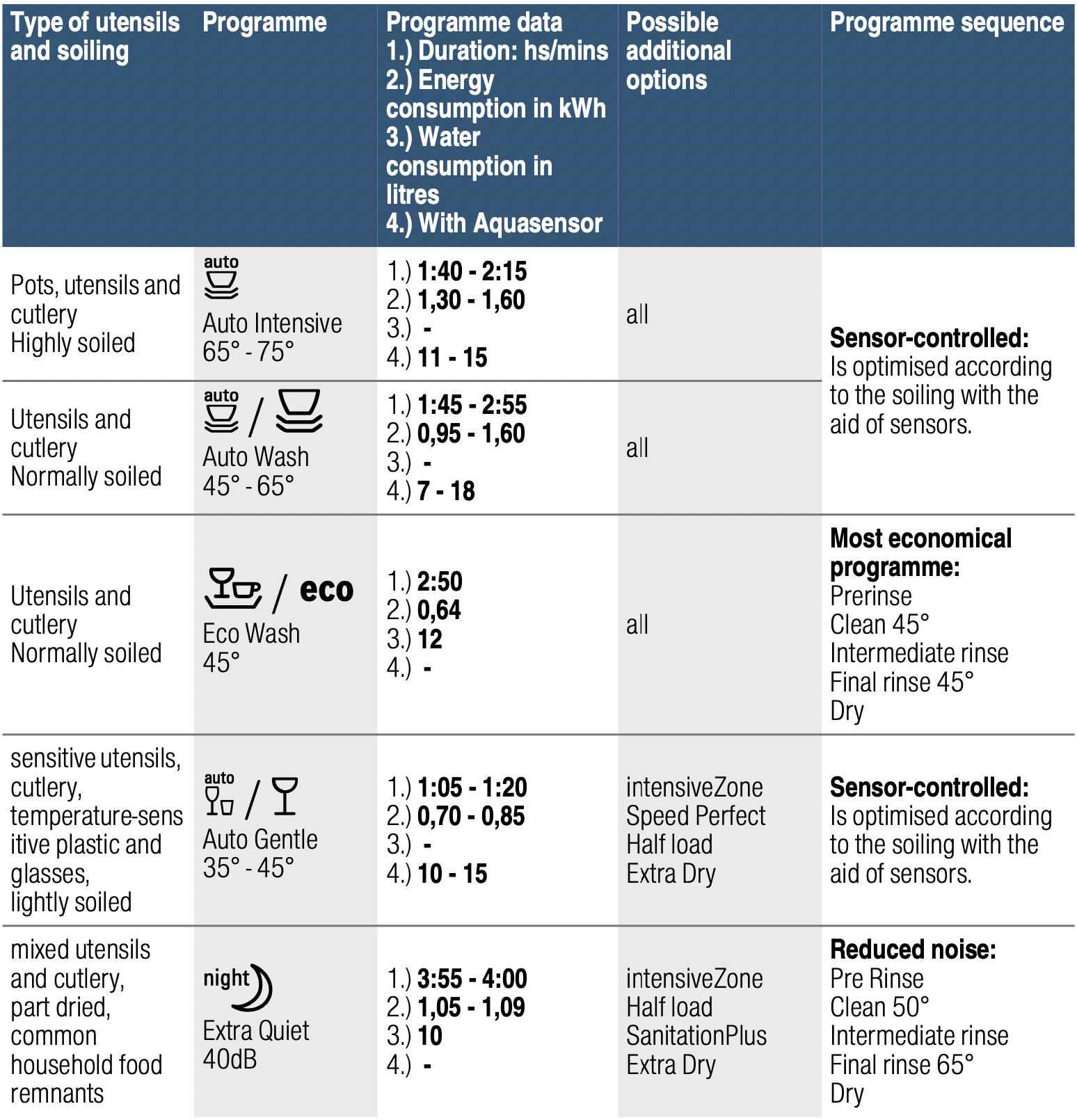
* depending on the features of your dishwasher
Etagere *
The etagere and the space underneath can be used for small cups and glasses or for larger items of cutlery, such as wooden spoons or serving cutlery. If you do not require the etagere, it can be folded up.
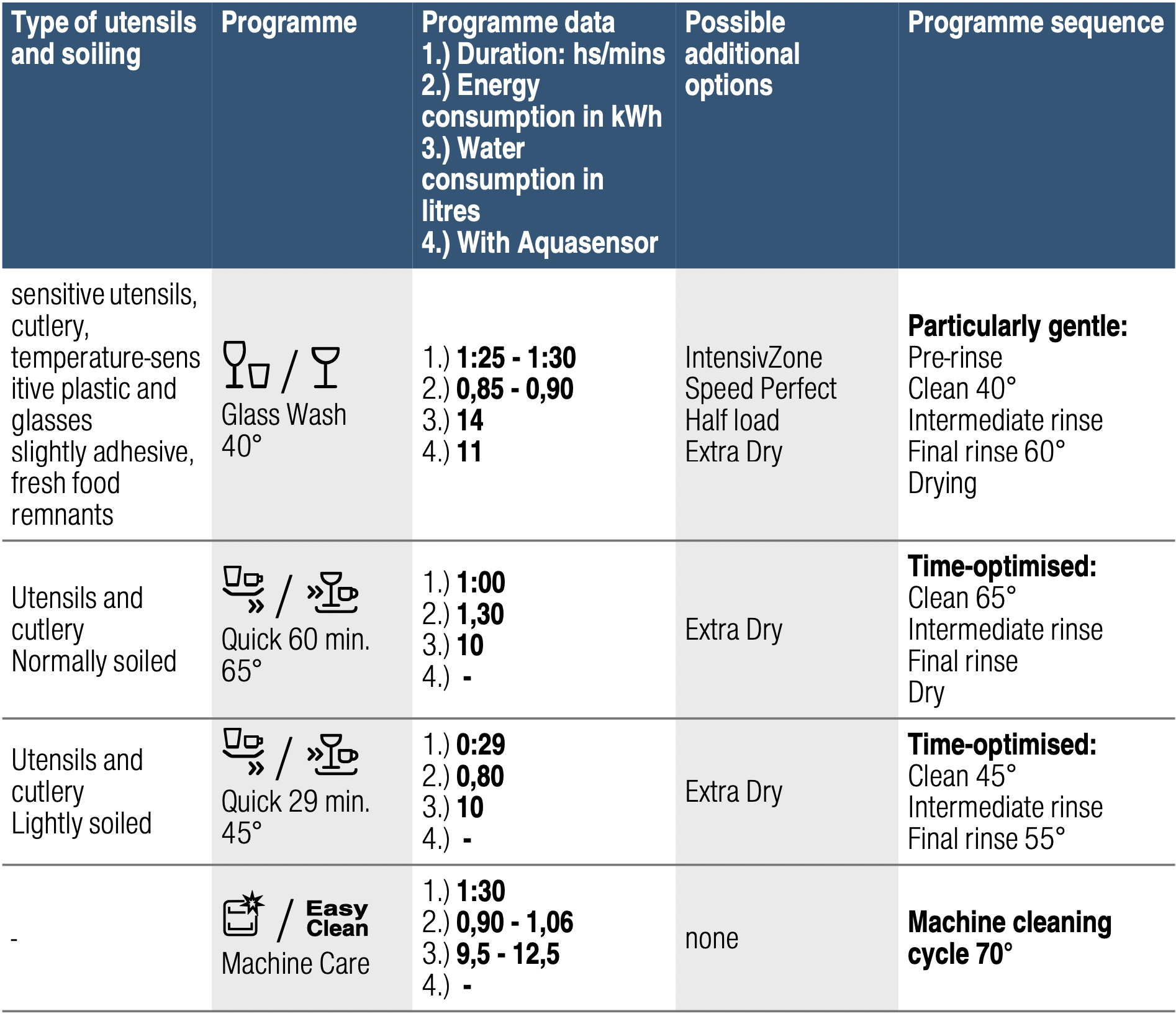
* Depending on the features of your dishwasher, you can adjust the etagere 3 times the height.
Adjust the height of the etagere as follows:
- Position the etagere vertically and pull upwards.
- Push etagere at a slight angle downwards to the required height (1, 2, or 3).
- Engage etagere.
Etagere “clicks” into position.
Folding spikes *
* Depending on the features of your dishwasher, the spikes can be folded down. This facilitates arrangement of pots, bowls and glasses.
Fold down the spikes as follows:
- Press lever forwards (1).
- Fold down spikes (2).
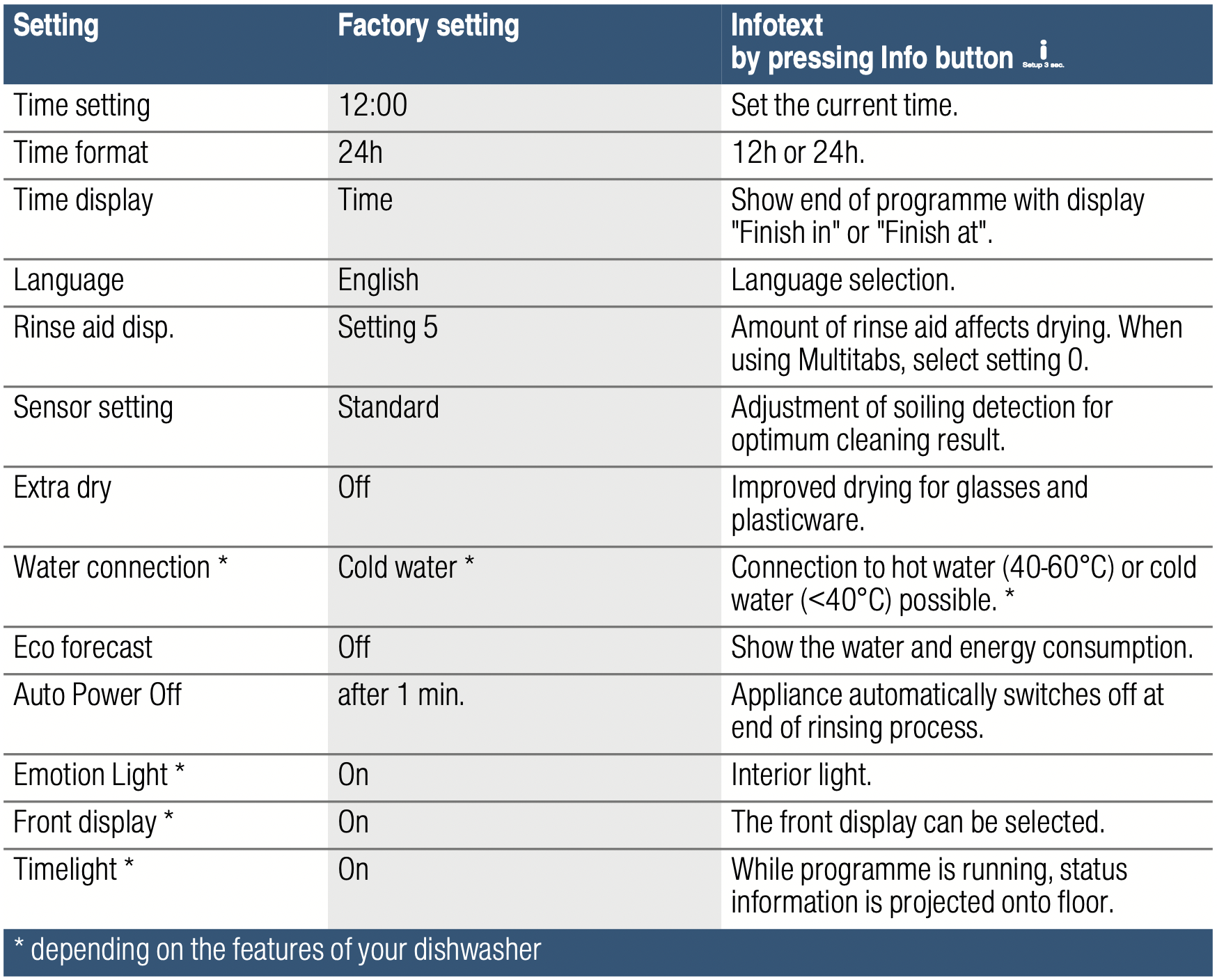
Small items holder *
* Depending on the features of your dishwasher, the upper basket is fitted with small items holders. The small items holders can be used to securely attach light plastic parts.

Knife rack *
* Depending on the features of your dishwasher, the upper basket is fitted with a knife shelf. Long knives and other utensils can be placed in the knife shelf.
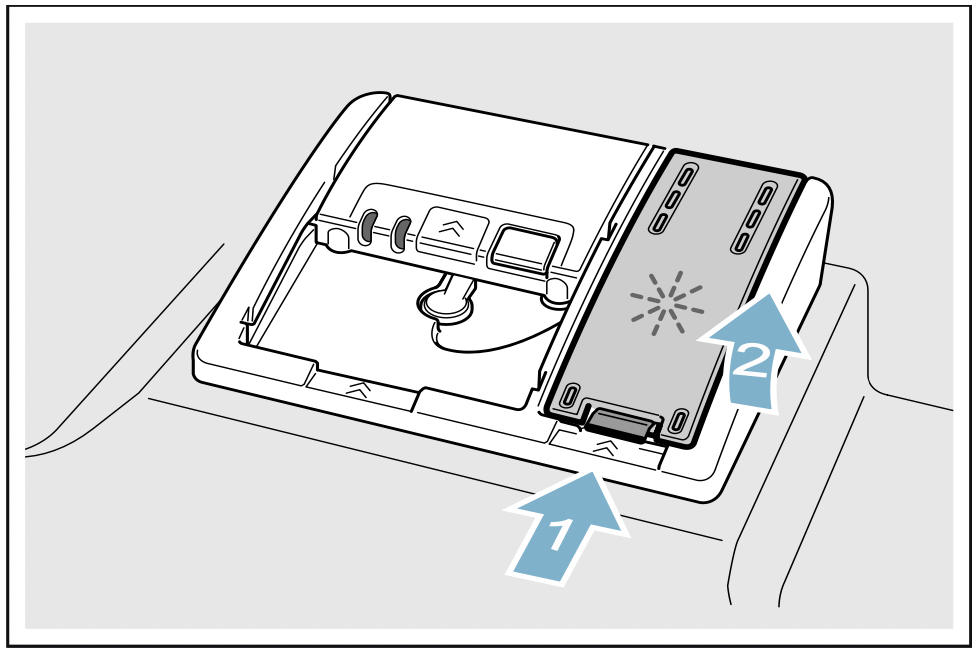
Baking sheet spray head *
* depending on the features of your dishwasher
Large trays or grilles as well as large plates (gourmet plates, pasta plates, dinner plates) can be cleaned with this spray head.
Insert the spray head as follows:
- Remove upper basket 22.
- Insert spray head as illustrated and turn to the right.
Spray head is engaged.
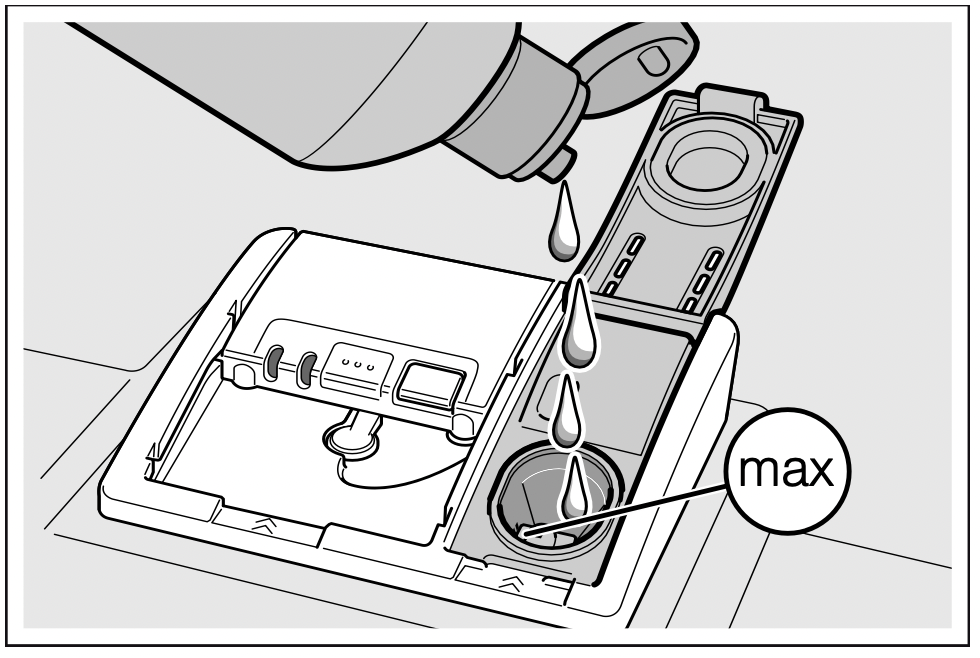
To ensure that the spray jet can reach all parts, arrange the baking sheets as illustrated (max. 2 baking sheets and 2 grilles).
Note: Ensure that the dishwasher is always operated with upper basket 22 or baking tray spray head.
Unloading the dishwasher
To prevent water from dripping off the upper basket onto the utensils in the lower basket, it is recommended to empty the appliance from the bottom up.
Tip: Hot utensils are sensitive to shock! Therefore, when the programme ends, leave the utensils to cool down in the dishwasher until they can be handled.
Note: When the programme ends, water droplets can still be seen inside the appliance. This does not affect the drying of the utensils.
Adjusting the height of the basket *
* depending on the features of your dishwasher
If required, the height of the upper basket 22 can be adjusted to create more space for taller utensils either in the upper or lower basket.
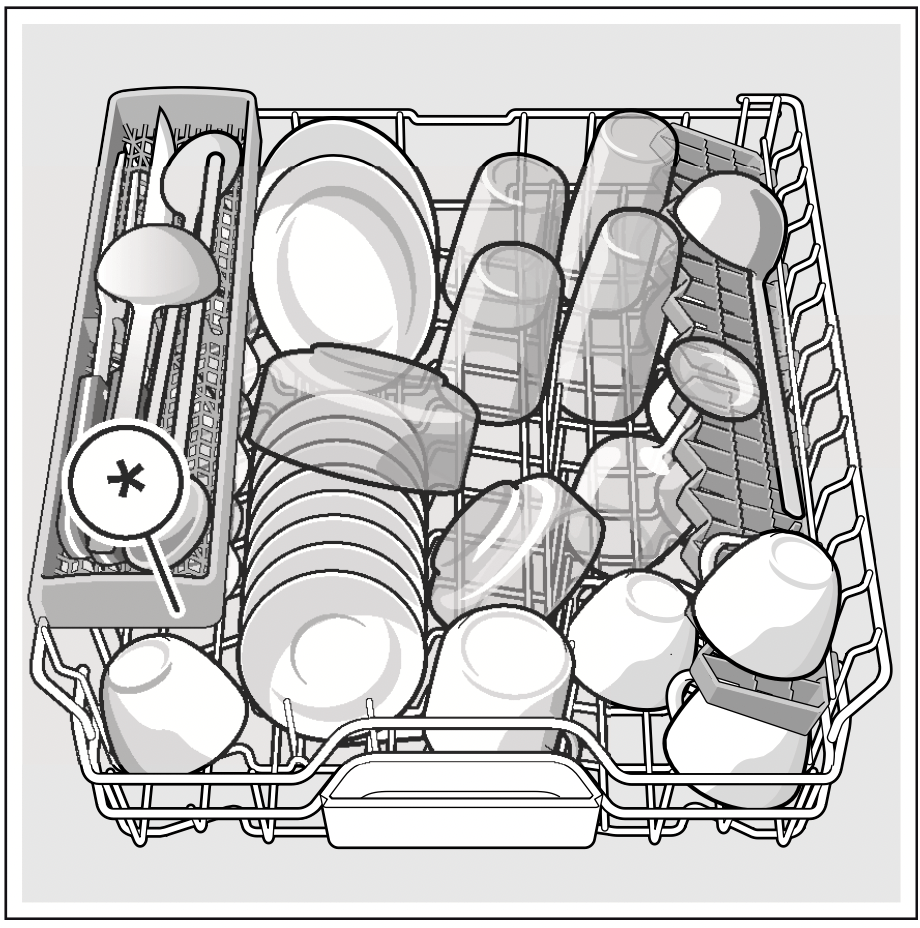
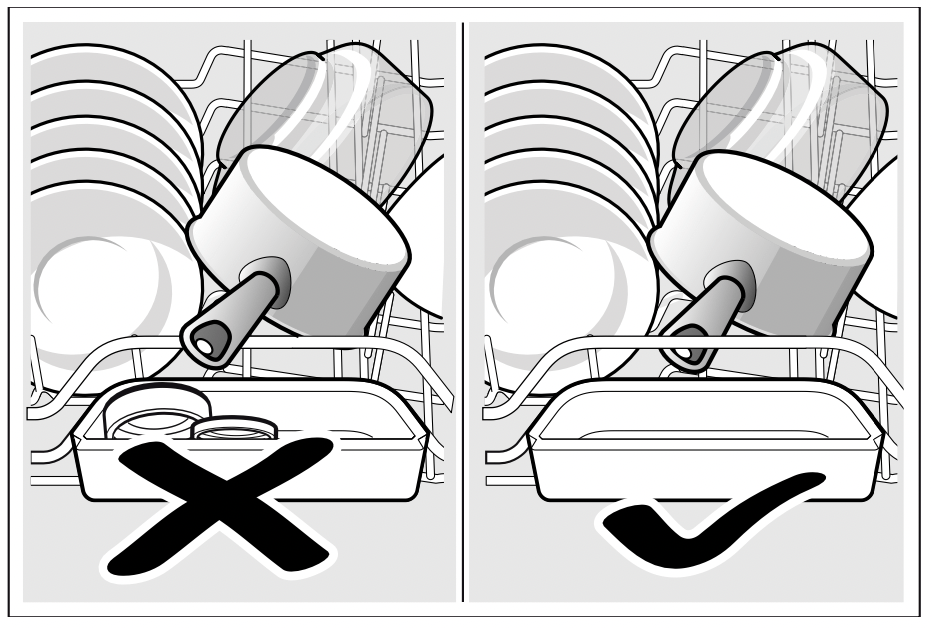
Arrange large plates up to a diameter of 31/34* cm in the lower basket 28 as illustrated.
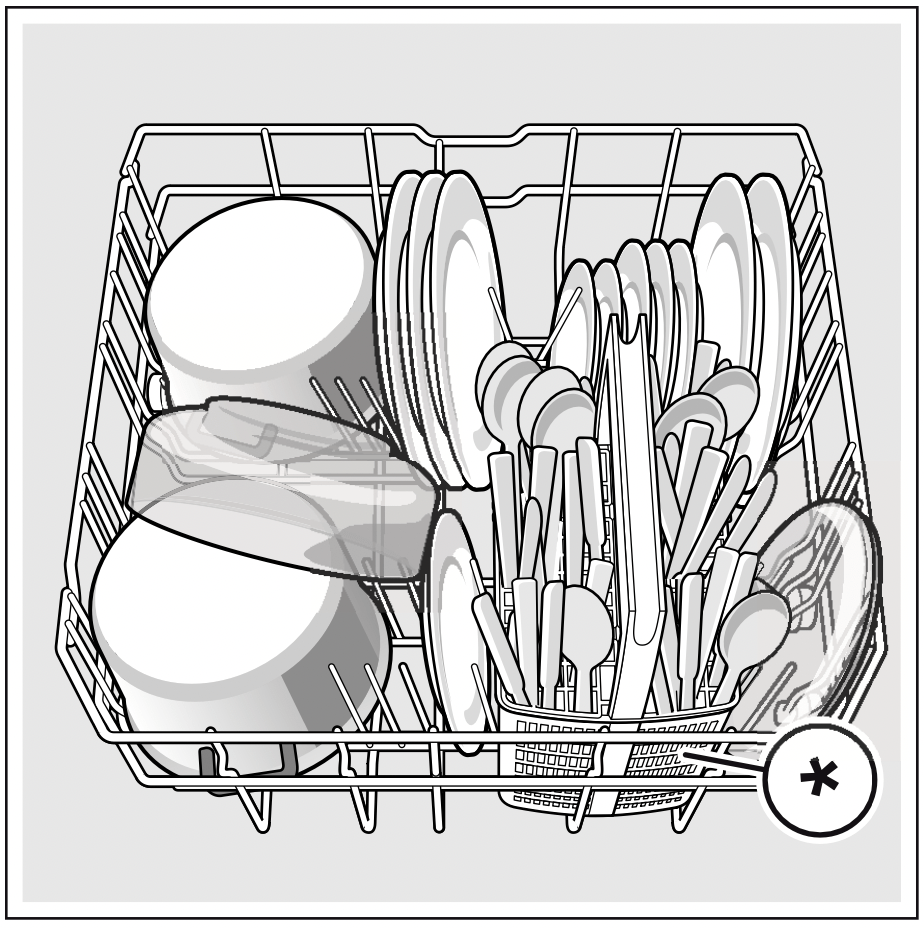
* depending on the features of your dishwasher
Upper basket with side levers
- Pull out upper basket 22.
- Hold the sides of the basket along the upper edge.
This prevents it from suddenly dropping. - To lower the upper basket; press in both levers on the left and right on the outside of the basket. The upper basket lowers.
[IMAGE] - To lift the upper basket; grip the sides of the upper basket along the upper edge and lift.
- Ensure that both sides of the upper basket are at the same height.
- Push in upper basket.
Upper basket with upper and lower pairs of rollers
- Pull out upper basket 12.
- Remove upper basket.
- Re-attach upper basket to the upper (Setting 3) or lower (Setting 1) rollers.
[IMAGE] - Push in upper basket.
Detergent
You can use tablets as well as powder or liquid detergents for dishwashers, but never use washing-up liquid. The dosage can be individually adjusted with powder or a liquid detergent according to the degree of soiling. Tablets contain an adequately large amount of active ingredients for all cleaning tasks. Modern, powerful detergents predominantly use a low-alkaline formulation with enzymes. Enzymes break down starch and remove protein. To remove coloured stains (e.g. tea, ketchup), oxygen-based bleaching agents are generally used.
Note: To ensure a good washing result, always follow the instructions on the detergent packaging!
If you have further questions, we recommend that you contact the detergent manufacturers’ helplines.
Warning - Risk of injury and damage due to non-observance of the safety instructions for detergent and rinse-aid products!
Always follow the safety instructions for detergent products and rinse-aid products.
Adding detergent
- If the detergent dispenser 30 is still closed, actuate locking bar 9* to open it.
- Pour detergent into the dry detergent dispenser 30 only (insert tablet flat, not on its edge).
- Dosage: see manufacturer’s instructions on the packaging. Use graduated detergent dispenser. Usually 20 ml–25 ml are adequate for normal soiling. If using tablets, one tablet is adequate.
[IMAGE] - Close cover on the detergent dispenser.
Cover “clicks” into position.
[IMAGE]
The detergent dispenser opens automatically at the optimum time depending on the programme. The powder or liquid detergent is distributed in the appliance and is dissolved, the tablet falls into the tablet collecting tray where it dissolves in doses.
Tip: If the utensils are only lightly soiled, slightly less than the indicated amount of detergent is usually adequate.
Suitable detergents and care products can be purchased online via our website or via customer service (see back page).
Notes
- If programmes are short, tablets may not have full cleaning effect due to different dissolving properties and there may even be undissolved detergent residue. It is recommended to use washing powder for these programmes.
- The Intensive programme (on some models) requires one tab only. When using washing powder, you can apply some of this cleaning agent to the inside of the appliance’s door.
- If using detergents in a water-soluble protective cover: Take hold of the cover with dry hands only and put the detergent into an absolutely dry detergent dispenser only, otherwise the detergent may stick.
- If you switch from combined detergents to solo detergents, ensure that the water softening system * and amount of rinse aid have been set to the correct value.
* depending on the features of your dishwasher
Overview of programmes
The max. possible number of programmes is illustrated in this overview. The corresponding programmes for your appliance can be found on the fascia. The programme data has been measured in the laboratory according to AS/NSZ 2007.
Note: The consumption figures depend on the selected programme and additional functions. The programme duration will be different if the machine is short of rinse additive or the function is turned off.
[IMAGE]
[IMAGE]
Programme selection
You can select a suitable programme according to the type of utensils and type of soiling.
Additional functions
* Depending on the features of your dishwasher, you can select different additional functions 8.
 Speed Perfect *
Speed Perfect *
This function can reduce the running time by approx. 20% to 50% depending on the selected rinse programme. To obtain optimum cleaning and drying results at a reduced running time, water and energy consumption are increased.
 Half load *
Half load *
If you have only a few items to wash (e.g. glasses, cups, plates), you can switch to “half load”. This will save water, energy and time. It is recommended to put a little less detergent in the detergent dispenser than for a full load.
 hygienePlus (HygienePlus) *
hygienePlus (HygienePlus) *
This function increases the temperatures and retains them for an extra long time to obtain a defined disinfection performance. Continuous use of this function increases the hygiene status. This additional option is ideal for cleaning e.g. chopping boards and baby bottles.
 intensiveZone *
intensiveZone *
Perfect for a mixed load. You can wash very soiled pots and pans in the lower basket together with normally soiled utensils in the upper basket. The spray pressure in the lower basket is intensified, the rinsing temperature is increased slightly.
 Extra Dry *
Extra Dry *
An increased temperature during the final rinse and an extended drying phase ensure that even plastic parts dry better. There is a slight increase in the energy consumption.
Operating the appliance
Changing the settings
The dishwasher has been preset with certain settings for your convenience. You can change these factory settings.
Change the setting as follows:
- Open the door.
- Switch on ON/OFF switch 1.
- Press Info button
 3 for 3 seconds until the following text is indicated on the display window at the top 4:
3 for 3 seconds until the following text is indicated on the display window at the top 4:
Scroll with < >
Set with - +
Leave with Setup 3 sec. - Keep pressing button > 10 until the required setting is indicated on the display window at the top 4.
- Make the setting with setting buttons + - 6.
- Press and hold the Info button
 3 for 3 seconds.
3 for 3 seconds.
The chosen setting has now been stored.
Tip: If you change several settings, first make all changes in succession. Now press the Info button  3 for 3 seconds. This saves all set values in the appliance.
3 for 3 seconds. This saves all set values in the appliance.
AquaSensor *
* depending on the features of your dishwasher
The Aqua sensor is an optical measuring device (light barrier) which measures the turbidity of the rinsing water.
The AquaSensor is used according to the programme. If the AquaSensor is active, “clean” rinsing water can be transferred to the next rinse bath and water consumption can be reduced by 3–6 litres. If the turbidity is greater, the water is drained and is replaced with fresh water. In the automatic programmes the temperature and running time can also be adjusted to the degree of soiling.
Time display
The running time is determined during the programme by the water temperature, the number of utensils as well as the degree of soiling and may vary (depending on the selected programme). You can change the time display in time or hours/minutes so that the remaining running time of the rinsing progamme appears in the display window “Ready at” (for example 15:20 hours) or “Ready in” (for example 3:25).
Sensor setting
The programme sequence is optmised in Auto programmes with the aid of sensors. The sensors adjust the programme strength of Auto programmes depending on the amount and type of soiling. You can adjust the sensitivity of the sensors in 3 stages.
Standard: This setting is ideal for a mixed load and heavily soiled utensils, but also saves energy and water.
Sensitive: This setting adjusts the programme strength for the effective removal of food remnants, even if the amount of soiling is low. The energy and water consumption is adjusted accordingly.
Very sensitive: This setting adjusts the programme strength for difficult conditions of use, for example firmly dried on food remnants. This setting is recommended if using biological or eco detergents which contain lower amounts of active agents. The energy and water consumption is adjusted accordingly.
extraDry
The final rinse uses a higher temperature which improves the drying result. The running time may increase slightly. (Caution if utensils are delicate!) You can switch the extraDry function on or off.
Eco forecast
When Eco forecast is activated, the average water and energy consumption of the selected programme is briefly displayed on the display window at the top 4.
AutoPowerOff (Switching off automatically after the end of the programme)
To save energy, the dishwasher is switched off 1 minute after the programme ends. You can also change this setting.
Possible settings are:
- off: The appliance does not switch off automatically.
- After one minute: The appliance switches off after 1 minute.
- After two hours: The appliance switches off after 2 hours.
Note: Note that for the settings "After one minute" and "After two hours", the interior lighting 20 is switched off. To activate the interior lighting, press the ON/OFF switch 1.
emotionLight (interior lighting) *
* Depending on the features of your dishwasher
EmotionLight 20 is the interior lighting for your dishwasher. You can switch the interior lighting on or off.
Notes
- Depending on the setting of AutoPowerOff, the interior lighting is either switched on or off.
- Note that the interior lighting is automatically switched off after 1 hour when it is switched on and the door is open.
Front display *
* depending on the features of your dishwasher
You can switch the front display 12 on or off (additional programme information).
TimeLight (Optical display while the programme is running) *
* depending on the features of your dishwasher
While programme is running, an optical display (additional programme information) is indicated on the floor under the appliance door. If the base panel is pulled forwards or if the appliance is installed at eye-level with flush furniture front, the display is not visible.
You can switch the optical display on or off.
Infolight *
* depending on the features of your dishwasher
While the programme is running, a light spot shines on the floor under the appliance door. Do not open the appliance door until the light point is no longer visible on the floor. If the appliance door is not completely closed, the light spot flashes *. If the appliance is installed at eye-level, with flush furniture front, the light point is not visible. You can switch the Infolight on or off.
Changing start programme *
* depending on the features of your dishwasher
You can change the “Start programme” setting.
Tone volume*
* depending on the configuration of your specific dishwasher
The end of the programme is indicated by a buzzer. You can also change this setting.
Button volume
When you are operating the dishwasher, a signal sounds whenever a button is pressed. You can control the volume of the signal. If you do not like the button volume, you can switch it off.
Child-proof lock *
* depending on the features of your dishwasher
The dishwasher features an electronic child-proof lock. The child-proof lock protects children from potential hazards which the dishwasher poses.
You can switch the child-proof lock on or off. When the child-proof lock is on, it is difficult to open the door.
Greeting
When you switch on the dishwasher, the brand logo appears. You can switch off the brand logo.
Factory setting
You can reset all settings to the factory setting.
Switching on the appliance
- Turn tap fully on.
- Switch on ON/OFF switch 1.
The displays for the last programme and last additional function selected flash. These settings will be retained unless another 2 programme key is pressed. - Press the START button 9.
Programme sequence starts.
Time preselection
You can delay the start of the programme by up to 24 hours. Depending on the setting of the time display, the end of programme is indicated with “Finish in” (for example 3h 25m) or “Finish at” (for example 15:20 hours).
- Open the door.
- Switch on ON/OFF switch 1.
- Selects programme 2.
- Press time preselection button 7.
- Keep pressing the setting buttons + 6 until the displayed time corresponds with your requirements.
- Press START button 9, timer programming is activated.
- To delete the time preselection, press START button 9 for approx. 3 seconds.
Time preselection was terminated. - Close the door.
Programme end
* The programme has ended when “Finished” is indicated on the display window at the top 4 and on the front display * 12.
* The end of the programme is displayed on the floor – provided the TimeLight (optical display) is switched on and is visible.
* depending on the features of your dishwasher
Switching off the appliance
Short time after the end of the programme:
- Open the door.
- Switch off ON/OFF switch 1.
- Turn off tap (does not apply to appliances with Aqua-Stop).
- Remove the utensils when they have cooled down.
Note: When the programme ends, leave the appliance to cool down a while before opening it. This will prevent steam from escaping and causing long-term damage to your built-in furniture.
Interrupting the programme
Caution! Expansion (overpressure) may cause the appliance door to jump open and/or water to escape! If the door was opened on an appliance which has a hot water connection or is heated, always leave the door ajar for several minutes and then close.
- Open the door.
- Switch off ON/OFF switch 1.
The LEDs go out. The programme is saved. - To continue the programme, switch on the ON/OFF switch 1 again.
- Close the door.
Terminating the programme (Reset)
- Open the door.
- Press the START button 9 and hold for 3 seconds The display window at the top 4 and the front display * 12 show: "Program was terminated".
- Close the door.
The programme sequence lasts approx. 1 min. The display window at the top 4 shows: “Finished”. - Open the door.
- Switch off ON/OFF switch 1.
- Close the door.
* depending on the features of your dishwasher
Changing the programme
When the START button 9 has been pressed, the programme cannot be changed. The only way a programme can be changed is by Cancel programme (Reset).
Cleaning and maintenance
A regular inspection and maintenance of your machine will help to prevent faults. This saves time and prevents problems.
Overall status of the dishwasher
*The interior of your dishwasher is predominantly self-cleaning. In order to remove deposits, your dishwasher automatically changes the running of the programme (such as by increasing the cleaning temperature) at certain intervals. This will lead to higher consumption values when running this programme.
*Depending on the features of your dishwasher
If you should find deposits in the interior of the dishwasher in spite of this, remove these deposits as follows:
- Fill the detergent dispenser 30 with detergent.
- Select the programme with the highest temperature.
- Start the programme without dishes.
Warning Health hazard due to detergents containing chlorine! Always use chlorine-free detergents.
Notes
- Only clean the appliance with special detergents/appliance cleaners which are suitable for use with dishwashers.
- Regularly wipe the door seals using a damp cloth and a little washing-up liquid. This will keep the door seal clean and hygienic.
- Leave the door open slightly if the appliance will not be used for a while. This will prevent an unpleasant odour from developing.
- Never clean the dishwasher using a steam cleaner. The manufacturer is not liable for any consequential damage.
- Wipe the front of the dishwasher and the control panel regularly using a damp cloth and a little washing-up liquid.
- Do not use sponges with a rough surface or abrasive detergents. These could scratch the surface.
- For dishwashers with a stainless steel front, avoid using sponge cloths, or rinse these thoroughly several times before using them for the first time. This will prevent corrosion.
Machine Care [IMAGE]*
Machine Care used in combination with commercially available machine cleaning detergent is a suitable programme for cleaning your dishwasher. Deposits such as grease and limescale can cause your dishwasher to malfunction. In order to avoid such faults and to reduce the development of odours, we recommend cleaning the dishwasher at regular intervals.
* As soon as the Machine Care display lights up in the control panel, or you are advised to do so on the front display, run the Machine cleaning programme Machine Care without loading any tableware. After you have run the Machine Care the display in the control panel will go out.
If your dishwasher does not have a reminder function, follow the instructions for use on the machine cleaning detergents.
Notes
- Remove any coarse soiling in the interior using a damp cloth.
- Run the programme without dishes, and in combination with a machine cleaning detergent.
- Use a special machine cleaning detergent, and not dishwasher detergent.
- Observe the safety instructions and the instructions for use on the machine cleaning detergent packaging.
- *After three rinse cycles, the display in the control panel will go out automatically, even if you have not run the Machine cleaning cycle programme.
* depending on the features of your dishwasher
Rinse aid
As soon as the refill indicator are lit on the fascia 5 or there is a request in the display window * 12, rinse aid should be topped up.
* depending on the features of your dishwasher
Filters
The filters 26 keep large foreign objects in the rinsing water away from the pump. hese foreign objects may occasionally block the filters.
The filter system consists of
- a coarse filter
- a flat fine filter
- a microfilter
- After each washing cycle check the filters for residue.
- Unscrew filter cylinder as illustrated and take out filter system.
[IMAGE] - Remove any residue and clean filters under running water.
- Re-install filter system in reverse sequence and ensure that the arrow marks are opposite each other after closing the filter system.
Spray arms
Limescale and contaminants in the rinsing water may block nozzles and bearings on the spray arms 23 and 25.
- Check outlet nozzles on the spray arms for blockages.
- Unscrew the upper spray arm 23 (1) and remove downwards (2).
- Remove the lower spray arm 25 upwards.
[IMAGE] - Clean spray arms under running water.
- Re-engage or screw on spray arms.
Fault, what to do?
Experience has shown that you can rectify most faults which occur in daily operation yourself. This ensures that the appliance is quickly available to you again. In the following overview you can find possible causes of malfunctions and helpful information for rectifying them.
Note: If the appliance stops during dishwashing or does not start for no obvious reason, first run the Abort programme function (Reset). "Operating the appliance" on page 28.
Warning - Improper repairs or use of non-original spare parts may cause considerable damage and put the user at considerable risk! Always have repairs carried out by technicians. If a component has to be replaced, always use original spare parts.
Error message
Some faults are indicated at the top of the display window 4 and on the front display * 12 and possible remedies are offered (for example Filter system soiled (E22) -->Clean filters).
* depending on the features of your dishwasher
Waste water pump
Large food remnants or foreign objects which were not captured by the filters may block the waste water pump. The rinsing water will then be above the filter.
Warning - Danger of cutting!
- Sharp and pointed objects or glass fragments may block the waste water pump.
- Always carefully remove foreign objects.
Clean the waste water pump as follows:
- Disconnect the dishwasher from the power supply.
- Take out top basket 22 and bottom basket 28.
- Remove the filters 26.
- Scoop out water, use a sponge if required.
- Prise off the pump cover (as shown) using a spoon. Grip the pump cover by the crosspiece and lift diagonally inwards (1). Remove cover completely.
[IMAGE] - Check impeller wheel and remove any foreign objects.
- Place pump cover in the original position (2) and press down until it engages (3).
[IMAGE] - Install filters.
- Re-insert baskets.
Fault table
Fault | Cause | Remedial action |
| Error code [IMAGE] is lit. | Intake opening (on right inside of appliance) covered by utensils. | Arrange utensils so that the intake opening is not obstructed. |
| Error code [IMAGE] is lit. | Heating element calcified or soiled. | Clean appliance with dishwasher cleaning agent or descaler. Operate the dishwasher with water softening system and check the setting. |
| Error code [IMAGE] is lit. | Supply hose kinked. | Install supply hose without kinks. |
| Tap turned off. | Turn on the tap. | |
| Tap jammed or calcified. | Turn on the tap. Flow rate must be min. 10 l/min. when water supply is open. | |
| Filter in the water supply blocked. | Switch off the appliance and pull out the mains plug. Turn off the tap. Unscrew water connection. [IMAGE] Clean filter in the supply hose. Screw water connection on again. Check for leaks. Reconnect power supply. Switch on the appliance. | |
| Error code [IMAGE] is lit. | Filters 26 are soiled or blocked. | Clean filters. "Filters" on page 34 |
| Error code [IMAGE] is lit. | Waste-water hose kinked or blocked. | Install hose without kinks, remove any residue. |
| Siphon connection still sealed. | Check connection to siphon and open if required. | |
| Cover on the waste water pump loose. | Lock cover correctly. "Waste water pump" on page 36 | |
| Error code [IMAGE] is lit. | Waste water pump blocked or cover on the waste water pump is not locked in position. | Clean pump and lock cover correctly. "Waste water pump" on page 36 |
| Error code [IMAGE] is lit. | Mains voltage too low. | Not an appliance fault, have the mains voltage and electrical installation checked. |
| A different error code is indicated on the digital display. ([IMAGE] to [IMAGE]) | A technical fault has probably occurred. | Switch off appliances with the ON/OFF switch 1. After a short time restart the appliance. If the problem recurs, turn off the tap and pull out the mains plug. Call customer service and mention the error code. |
| Refill indicator for rinse-aid 5 islit. | No rinse aid. | Refill rinse aid. |
| Refill indicator for rinse-aid 5 isnot lit. | Refill indicator switched off. | Activation/deactivation. "Rinse aid" on page 16 |
| There is still enough rinse aid available. | Check refill indicator, levels. | |
| Water is left in the appliance at the end of the programme. | Filter system or area under the filters 26 is blocked. | Clean filters and area under neath. |
| Program has not ended yet. | Wait until programme ends or reset. | |
| Utensils not dry. | No or too little rinse aid in the dispenser. | Refill rinse aid. |
| Programme selected without drying. | Select programme with drying. | |
| Water collecting in depressions on theutensils and cutlery. | Arrange utensils in a sloping position, arrange affected utensils assloping as possible. [IMAGE] | |
| The combined detergent used has a poor drying performance | Use different combination detergent with better drying performance. Use of rinse aid also increases the drying performance. | |
| ExtraDry to increase drying not activated. | Activate ExtraDry. | |
| Utensils were removed too early or drying process had not ended yet. | Wait until program ends or wait until 30 min after program ends before removing utensils. | |
| The eco rinse aid used has a limited drying performance. | Use a proprietary rinse aid. Eco products may have limited effectiveness. | |
| Plastic utensils not dry. | Special properties of plastic. | Plastic has a lower heat storage capacity and therefore dries less well. |
| Cutlery not dry. | Cutlery not arranged properly in the cutlery basket. | Separate cutlery if possible, prevent contact points. |
| Cutlery not arranged properly in the cutlery drawer. | Arrange cutlery properly and separate if possible. | |
| Appliance interior wet after rinse cycle. | No appliance fault | On account of the “Condensation drying” principle, water droplets are physically induced and required in the container. The humidity in the air condenses on the inner walls of the dishwasher, drains and is pumped out. |
| Food remnants on the utensils. | Utensils placed too closely together, utensils basket overfilled. | Arrange utensils with adequate clearance between them ensuring that the spray jets can reach the surface of the utensils. Prevent contact points. |
| Spray arm rotation obstructed. | Arrange utensils so that the spray arm can rotate without obstruction. | |
| Spray arm nozzles are blocked. | Clean the spray arm nozzles. "Cleaning and maintenance" on page 32 | |
| Filters 26 dirty. | Clean filters. "Cleaning and maintenance" on page 32 | |
| Filters 26 inserted incorrectly and/or not engaged. | Insert and engage filters correctly. | |
| Rinse programme too weak. | Select a more intensive rinse programme. Increase sensitivity of the sensors. "Sensor setting" on page 29 | |
| Utensils precleaned too intensely; sensors therefore decide on weak programme sequence. Stubborn soiling cannot be completely removed. | Do not prerinse utensils. Remove only large food remnants. Increase sensitivity of the sensors. "Sensor setting" on page 29 Recommended programme Intensive. | |
| Tall narrow receptacles in corner areas are not rinsed adequately. | Do not place hollow receptacles too obliquely and do not place in the corner area. | |
| Top basket 22 on right and left not set to same height. | Set top basket to same height using side levers. | |
| Detergent residue. | Detergent dispenser cover 30 blocked by utensils and therefore does not open fully. | Utensils must not be placed above the tablet collecting tray 24. These may block the lid of the detergent dispenser and prevent itfrom opening fully. "Upper basket" on page 18. Do not place utensils or fragrance dispenser in the tablet collecting tray. |
| Detergent dispenser cover 30 blocked by the tablet. | Tablet must be inserted flat and not upright. | |
Tablets used in the quick or short programme. Dissolving time of the detergent is not reached in the selected short programme. | Dissolving time of tablets too long for a quick or short programme. Use a detergent powder or select a more intensive programme. | |
| Washing effect and dissolving performance are reduced after a prolonged storage time or detergent is very lumpy. | Change detergent. | |
| Water stains on plastic parts. | Droplet formation on plastic surface is physically unavoidable. After drying, water stains are visible. | Use a more intensive programme (more water changes). Arrange utensils in a sloping position. Use rinse aid. |
| Washable or water-soluble coatings in the container or on the door. | Detergent substances are deposited. These coatings cannot usually be removed with chemicals (appliance cleaner, ...). | Change detergent brand. Clean appliance mechanically. |
| Only for glasses: Initial glass corrosion – can only apparently be wiped off. | See “Glass and utensil damage”, Page 17. | |
| White, stubborn coatings; limescale on the utensils, container or door. | Detergent substances are deposited. These coatings cannot usually be removed with chemicals (appliance cleaner, ...). | Change detergent brand. Clean appliance mechanically. |
| Underdosing of detergent. | Increase detergent dosage or change detergent. | |
| Too weak rinse programme selected. | Select a more intensive rinse programme. | |
| Tea or lipstick residue on the utensils. | Too low rinsing temperature. | Select programme with higher washing temperature. |
| Too little or unsuitable detergent. | Use suitable detergent at correct dosage. | |
| Utensils precleaned too intensely; sensors therefore decide on weak programme sequence. Stubborn soiling cannot be completely removed. | Do not prerinse utensils. Remove only large food remnants. Increase sensitivity of the sensors. "Sensor setting" on page 29 | |
| Coloured (blue, yellow, brown), difficult to remove to non-removable coatings in the appliance or on stainless steel utensils. | Film formation consisting of ingredients from vegetables (e.g. cabbage, celery, potatoes, noodles, ...) or the tap water (e.g. manganese). | Can be partly removed with machinecleaner or by mechanical cleaning. Coatings are harmless. |
| Film formation caused by metallic components on silver or aluminium utensils. | Can be partly removed with machine cleaner or by mechanical cleaning. | |
| Discolouration of the plastic parts inside the appliance. | Plastic parts inside the appliance may become discoloured during the service life of the dishwasher. | Discolouration is normal and will not impair the function of the dishwasher. |
| Plastic parts discoloured. | Too low rinsing temperature. | Select programme with higher washing temperature. |
| Utensils precleaned too intensely; sensors therefore decide on weak programme sequence. Stubborn soiling cannot be completely removed. | Do not prerinse utensils. Remove only large food remnants. Increase sensitivity of the sensors. "Sensor setting" on page 29 | |
| Removable streaks on glasses, glasses with metallic appearance and cutlery. | Too much rinse aid. | Set rinse aid amount to lower setting. |
| No rinse aid added or setting too low. | Add rinse aid and check dosage(recommended setting 4–5). | |
| Detergent residue in the final rinse programme section. Detergent dispenser cover blocked by utensils (cover does not open fully). | Detergent dispenser cover must not beobstructed by utensils. Do not place utensils or fragrance dispenser in the tablet collecting tray. | |
| Utensils precleaned too intensely; sensors therefore decide on weak programme sequence. Stubborn soiling cannot be completely removed. | Do not prerinse utensils. Remove only large food remnants. Increase sensitivity of the sensors. "Sensor setting" on page 29 | |
| Initial or existing, irrever sible clouding of glass. | Glasses not dishwasher-proof, only suitable for dishwasher. | Use dishwasher-proof glasses. Avoid long steam phase (standing time after wash cycle ends). Use wash cycle at lower temperature. Use detergent with glass protection component. |
| Rust spots on the cutlery. | Cutlery not adequately rust-resistant. Knife blades are frequently more severely affected. | Use corrosion-resistant cutlery. |
| Cutlery will also rust if rusting parts are rinsed at the same time (pan handles, damaged utensil baskets, etc.). | Do not wash rusting parts. | |
| Appliance cannot be switched on or operated. | Malfunction. | Disconnect appliance from the power supply; pull out the mains plug or switch off the fuse. Wait at least 5 seconds, then connect the appliance to the power supply. |
| Appliance does not start. | The mains fuse has tripped. | Check mains fuse. |
| Power cord not inserted. | Ensure that the power cord is plugged all the way into the back ofthe appliance and into the socket. Check that the socket functions. | |
| The appliance door has not been shut properly. | Close the door. | |
| Programme starts automatically. | You did not wait until programme ended. | Perform reset. |
| The door is difficult to open. | Child lock is activated. | Deactivate the child lock. |
| Door cannot be closed. | Door lock has been activated. | Close door with increased force. |
| Door cannot be closed due to installation. | Check appliance installation: Door or attached parts must close without obstruction. | |
| Cover on the detergent dispenser cannot be closed. | Detergent dispenser or cover guide blocked by sticky detergent residue. | Remove detergent residue. |
| Detergent residue in the detergent dispenser 30 or in the tablet collecting tray 24. | Spray arms blocked by utensils, therefore detergent is not rinsed out. | Ensure that the spray arms can rotate freely. |
| The detergent dispenser was damp when filled. | Pour detergent into the dry detergent dispenser only. | |
| Appliance stops in the programme or programme is interrupted. | Door not closed properly. | Close the door. |
Do not place utensils or fragrance dispenser in the tablet collecting tray. Top basket presses against the door and prevents door from being closed securely. | Check whether rear panel is being pressed in, e.g. by socket or by hose holder which has not been removed. | |
| Power and/or water supply interrupted. | Restore power and/or water supply. | |
| Filling valves making striking noises. | Depends on domestic installation, as appliance is not defective. No effect on appliance function. | No remedial action possible. |
| Knocking or rattling noise. | Spray arm strikes the utensils, utensils not positioned correctly. | Position utensils so that the spray arms do not strike the utensils. |
| If there is a low load, the water jets strike the washing tank directly. | Load the appliance with more utensils or distribute the utensils more evenly in the dishwasher. | |
| Light utensils move during the wash cycle. | Arrange light utensils securely. | |
| Unusual foam formation. | Handwash liquid in the rinse aid dispenser. | Immediately refill rinse aid dispenser with rinse aid. |
| Rinse aid spilled. | Remove rinse aid with a cloth. |
See other models: SMU88TS04A SMI88TS02A SMV88TX02A SPS60M08AU SMS50E32AU
